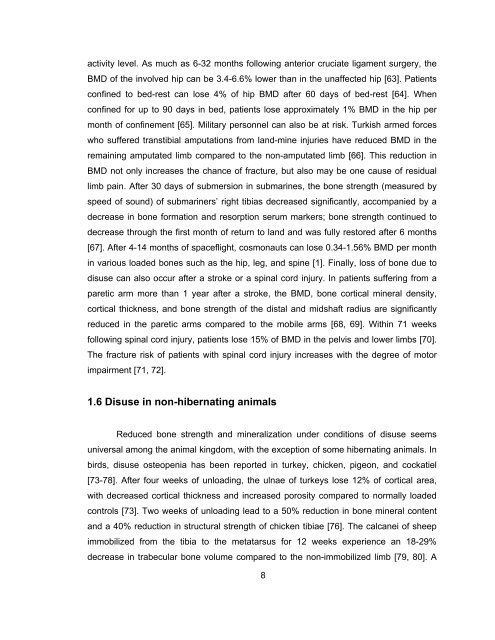C - Michigan Technological University
C - Michigan Technological University
C - Michigan Technological University
- No tags were found...
You also want an ePaper? Increase the reach of your titles
YUMPU automatically turns print PDFs into web optimized ePapers that Google loves.
activity level. As much as 6-32 months following anterior cruciate ligament surgery, theBMD of the involved hip can be 3.4-6.6% lower than in the unaffected hip [63]. Patientsconfined to bed-rest can lose 4% of hip BMD after 60 days of bed-rest [64]. Whenconfined for up to 90 days in bed, patients lose approximately 1% BMD in the hip permonth of confinement [65]. Military personnel can also be at risk. Turkish armed forceswho suffered transtibial amputations from land-mine injuries have reduced BMD in theremaining amputated limb compared to the non-amputated limb [66]. This reduction inBMD not only increases the chance of fracture, but also may be one cause of residuallimb pain. After 30 days of submersion in submarines, the bone strength (measured byspeed of sound) of submariners’ right tibias decreased significantly, accompanied by adecrease in bone formation and resorption serum markers; bone strength continued todecrease through the first month of return to land and was fully restored after 6 months[67]. After 4-14 months of spaceflight, cosmonauts can lose 0.34-1.56% BMD per monthin various loaded bones such as the hip, leg, and spine [1]. Finally, loss of bone due todisuse can also occur after a stroke or a spinal cord injury. In patients suffering from aparetic arm more than 1 year after a stroke, the BMD, bone cortical mineral density,cortical thickness, and bone strength of the distal and midshaft radius are significantlyreduced in the paretic arms compared to the mobile arms [68, 69]. Within 71 weeksfollowing spinal cord injury, patients lose 15% of BMD in the pelvis and lower limbs [70].The fracture risk of patients with spinal cord injury increases with the degree of motorimpairment [71, 72].1.6 Disuse in non-hibernating animalsReduced bone strength and mineralization under conditions of disuse seemsuniversal among the animal kingdom, with the exception of some hibernating animals. Inbirds, disuse osteopenia has been reported in turkey, chicken, pigeon, and cockatiel[73-78]. After four weeks of unloading, the ulnae of turkeys lose 12% of cortical area,with decreased cortical thickness and increased porosity compared to normally loadedcontrols [73]. Two weeks of unloading lead to a 50% reduction in bone mineral contentand a 40% reduction in structural strength of chicken tibiae [76]. The calcanei of sheepimmobilized from the tibia to the metatarsus for 12 weeks experience an 18-29%decrease in trabecular bone volume compared to the non-immobilized limb [79, 80]. A8
















